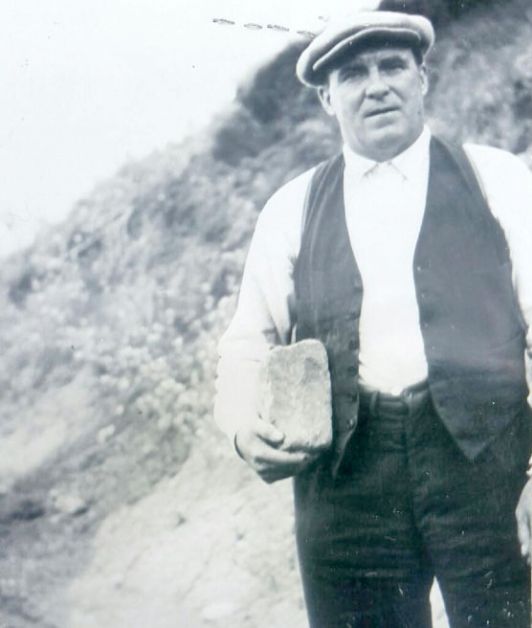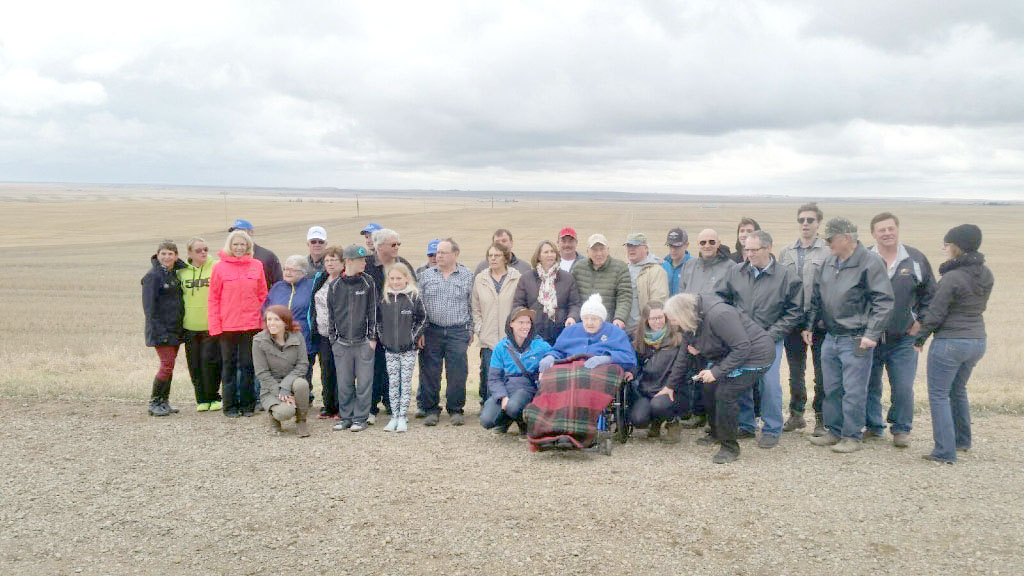
A century ago, a young miner near Champion named Harry Trentham was wondering whether he was breathing his last breath.
Today, there are 107 descendants of Harry, and many gathered last weekend at the very site where, for 87 hours, he tapped with a rock to allow rescuers to know where he was and to not lose hope.
Bob Grenville brought The Mail collection of newspaper clippings and reports recounting the more than three days that his grandfather was trapped. It tells a story of presence of mind, perseverance, and ingenuity.
At 8:30 a.m. on April 9, 1917, Harry Trentham went to work. He had settled in Three Hills by then, but learned of work in the Champion area. It was his first day, and he went to work at a small mine about seven miles north and a mile and half east of Champion, Alberta.
He was working in Room # 9, when at about 10:30 a.m. without warning it caved in. He was literally cut off from the outside world. In a Calgary Herald story 21 years later, Harry talked about the incident. At the time of the cave-in, he was moving a car of coal to the outlet of the shaft. He pushed the car back, keeping ahead of the falling debris until he came to a dead end. He piled rock, sand and anything else he could get his hand on to hold up the roof at the entry. He protected about a three square foot area at the end of the car. It allowed him a small air space, but he could hardly move. There he stayed for 87 hours.
About four hours after the cave-in, mine inspectors Moses Johnson, and Duncan McDonald, who later went on to manage the Murray Colliery in East Coulee, were called to the scene. They arrived at 6:30 p.m. that evening. The miners on scene worked in earnest, but in the eight hours since the cave in, they were only able to penetrate about three feet.
The Inspectors took control of the operations. Room 9 was about 180-190 feet from the entryway. Neither of the adjacent rooms were useful to access Trentham.
They continued to work trying to penetrate through the cave-in by driving piles ahead, and then putting in timbers when space was made.
This too, was a slow process and 30 hours after the cave-in they had only managed to move about 30 feet.
While it seemed hopeless, it was about that time, they received confirmation that Trentham was still alive. While they were digging, periodically they would tap on the pillar of coal in hopes of getting a response. At 4:30 p.m., on April 11, Trentham knocked back. This was the first sign that he was alive.
It was more than a knock. From this knocking, they were able to discern that he was using something very heavy to make the noise and that he was approximately 50 -60 feet away from the rescue party.
They decided to change their tack and sink a shaft from the surface to reach the miner.

They were in luck. Mr. Kidd, a surveyor from Drumheller was in the area at another mine. By working with the overman they pinpointed where to dig, and by 9:30 that night shovels were in the ground. While they were digging above, they left miners working on the cave-in underground so Trentham would hear work and not give up hope. When they reached 14 feet, they ceased digging in the cave-in, but left two miners down to push a mine car back and forth to force air to the entombed miner.
They continued to dig manually as using an explosive would have been too risky. The shaft connected to room #9 at 3 a.m. on April 13. At 5 a.m., they began to drive a tunnel towards Trentham.
Eventually they made a connection to the miner with an auger. A 1-inch pipe was inserted in the drill hole. They poured a mixture of water and brandy through the pipe. This was the first drink Trentham had in more than 85 hours.
They were able to talk to Trentham and he told them that everything around him was caved, so they had to proceed carefully. They reduced the size of the hole a to point that the smallest of the rescue party was able to reach through and grasp Trentham’s hand.
The tunnels from where they broke into the room, until they reached Trentham, was 36 feet and took 17 hours to construct. In talking to Trentham after the rescue, he said he only lost hope once, where it sounded like the workers were digging in the wrong direction.
It is not known how much longer he continued to work in Champion, however, he remained a miner. He discovered a seam of coal in a coulee in the Orkney area and there he built a life for his family. He had one daughter and five sons.
While he was within hours of death during those three days underground, it was Typhoid that struck him and one of his sons down in 1938.
His family endured and last week at the celebration there were more than 60 gathered including 15 of his grandchildren, Harry’s daughter Marjorie Grenville, 92, and his youngest son Bob Trentham, 89. The family even invented a new drink. Brandy and water is now known to the family as a “Harry Shot.”